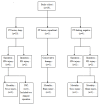The efficacy of four-slice helical CT in evaluating pancreatic trauma: a single institution experience
- PMID: 21214900
- PMCID: PMC3022694
- DOI: 10.1186/1752-2897-5-1
The efficacy of four-slice helical CT in evaluating pancreatic trauma: a single institution experience
Abstract
Study objective: To assess the efficacy of computed tomography (CT) in evaluating patients with pancreatic trauma.
Methods: We undertook a retrospective review of all blunt trauma patients admitted to the Chi-Mei Medical Center from January 2004 to June 2006. Every patients underwent abdominal CT scan in emergency department and the CT scans were obtained with a four-slice helical CT. Diagnosis of a pancreatic injury in these patients was by surgical observation or by CT findings. Radiographic pancreatic injuries were classified as deep or superficial lesions. Deep lesions were defined as the hematomas or lacerations >50% thickness of the pancreas. Superficial lesions were described as the hematomas or lacerations <50% thickness of the pancreas; pancreatic edema; and focal fluid accumulation around the pancreas
Results: Nineteen patients with pancreatic trauma, fourteen males and five females, average age 40.6 ± 21.4 years, were included. Most patients (73.7%) with pancreatic trauma had associated organ injuries. CT was performed in all patients and laparotomy in 14 patients. CT was 78.9% sensitive in detecting pancreatic trauma. All deep pancreatic lesions revealed on CT required surgical treatment, and complication was discovered in two patients undergoing delayed surgery. Superficial lesions were managed conservatively.
Conclusion: Four-slice helical CT can detect most pancreatic trauma and provide practical therapeutic guidance. Delayed operation might result in complications and is associated with prolonged hospital stays.
Figures


Similar articles
-
Paediatric blunt abdominal trauma: challenges of management in a developing country.Eur J Pediatr Surg. 2007 Apr;17(2):90-5. doi: 10.1055/s-2007-965008. Eur J Pediatr Surg. 2007. PMID: 17503300
-
Efficacy of computed tomography in the diagnosis of pancreatic injury in adult blunt trauma patients: a single-institutional study.Am Surg. 2002 Aug;68(8):704-7; discussion 707-8. Am Surg. 2002. PMID: 12206605
-
Management of pancreatic injury in pediatric blunt abdominal trauma.J Pediatr Surg. 1999 May;34(5):818-23; discussion 823-4. doi: 10.1016/s0022-3468(99)90379-2. J Pediatr Surg. 1999. PMID: 10359187
-
Performance of helical computed tomography without oral contrast for the detection of gastrointestinal injuries.Ann Emerg Med. 2004 Jan;43(1):120-8. doi: 10.1016/s0196-0644(03)00727-3. Ann Emerg Med. 2004. PMID: 14707951 Review.
-
Traumatic injuries: imaging and intervention in post-traumatic complications (delayed intervention).Eur Radiol. 2002 May;12(5):994-1021. doi: 10.1007/s00330-002-1396-0. Epub 2002 Mar 23. Eur Radiol. 2002. PMID: 11976843 Review.
Cited by
-
Pancreatic trauma: The role of computed tomography for guiding therapeutic approach.World J Radiol. 2015 Nov 28;7(11):415-20. doi: 10.4329/wjr.v7.i11.415. World J Radiol. 2015. PMID: 26644827 Free PMC article.
-
Computed tomography for pancreatic injuries in pediatric blunt abdominal trauma.World J Gastrointest Surg. 2012 Jul 27;4(7):166-70. doi: 10.4240/wjgs.v4.i7.166. World J Gastrointest Surg. 2012. PMID: 22905284 Free PMC article.
References
LinkOut - more resources
Full Text Sources

